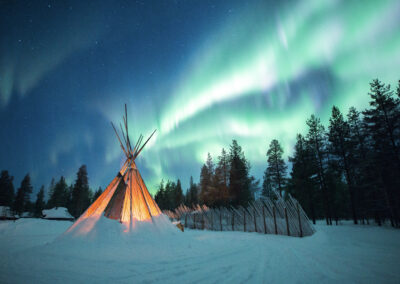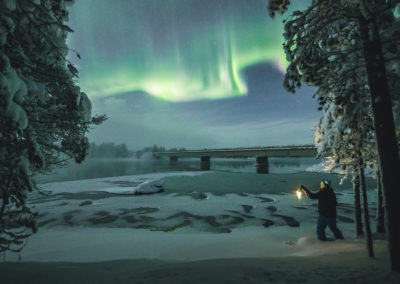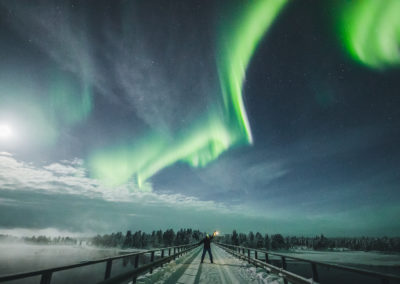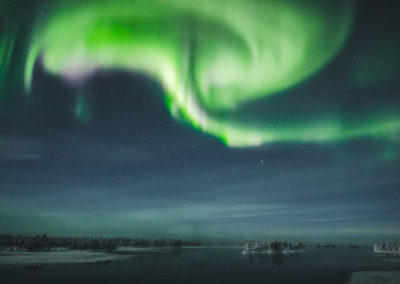When is the best time to see the Northern Lights?
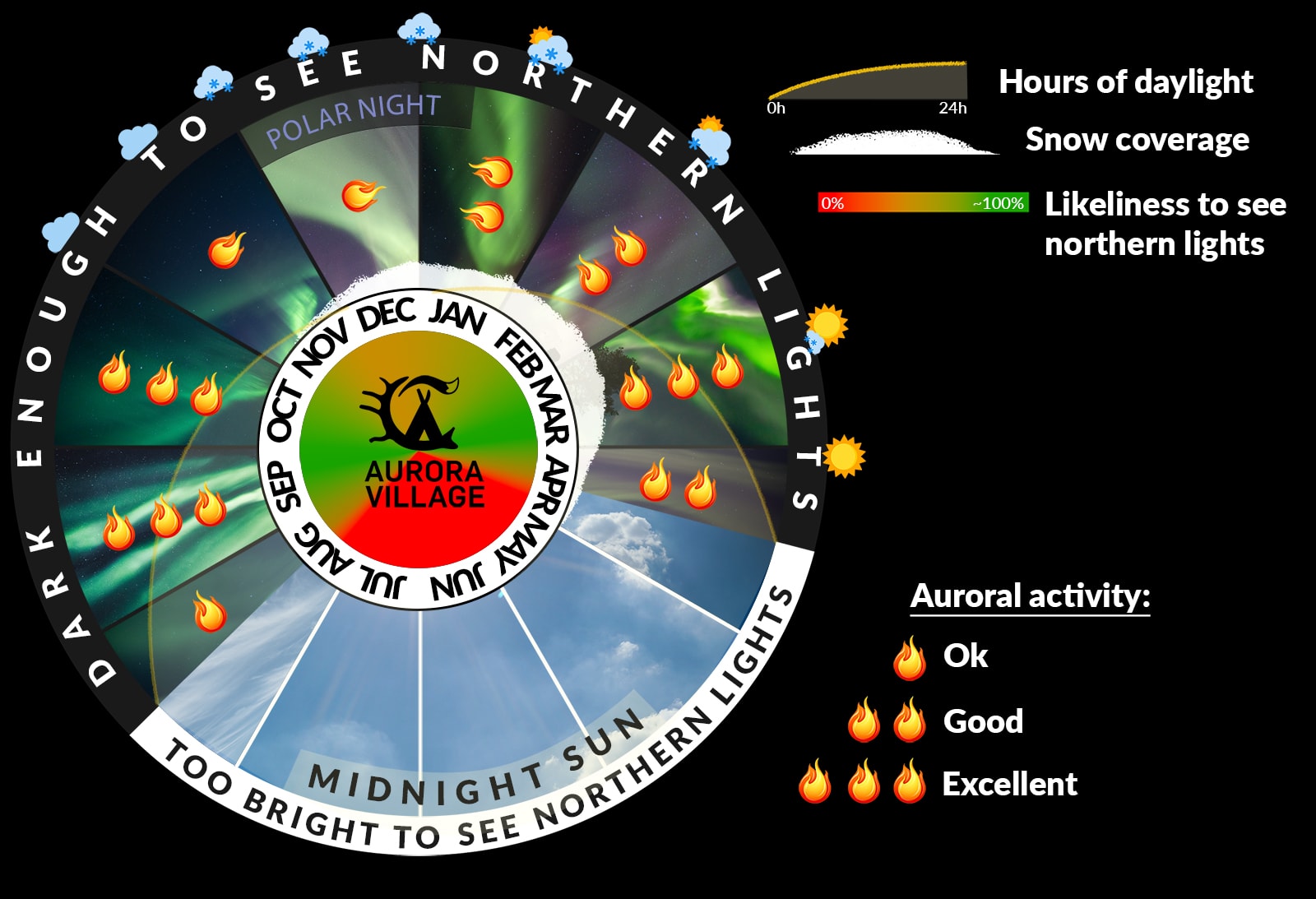
Best time to see the Northern Lights in Ivalo is September-October and March-April.
This chart is a generic presentation of Northern Lights visibility and activity levels for each month of a year. Northern Lights can be seen during 8-month period from mid-August until mid-April.
During summer time the nights are too bright for us to see the Northern Lights.
Generally speaking Northern Lights are most active around equinox dates in late September and late March. However, we see beautiful Northern Lights throughout the entire autumn and winter season.
Sometimes they can be barely noticed with naked eye for a brief moment, yet sometimes they dance vividly exploding all over the sky for entire night and longer.
You have to be lucky with both the weather on Earth (clear sky) and the space weather (strong solar wind with well directed magnetic fields).
8 MONTHS OF NORTHERN LIGHTS
Northern lights can be witnessed in Lapland for a remarkable 8-month period, spanning from early August until late April. Although the aurora activity persists throughout the year, the northern lights remain hidden during the summer months due to the brightness of the midnight sun. To maximize your chances of experiencing this awe-inspiring phenomenon, it is advisable to visit Lapland between the first week of September and the second week of April. During these months, the aurora activity is at its peak, especially during the autumn and spring equinoxes.
Scientifically proven, the equinox effect enhances the northern lights activity for several consecutive weeks, making September, October, March, and early April the prime time for aurora sightings.
Nevertheless, other months like November, December, January, and February also offer the opportunity to witness beautiful auroras. The equinoxes, however, hold a certain enchantment as the auroras appear to become more active, creating a truly magical experience.
JANUARY
LESS SNOWFALL – MORE CLEAR NIGHTS – COLD WEATHER – BETTER AURORAS
January is the extreme month for aurora hunting, renowned for its frigid temperatures and frequent displays of the lights. The sky above the snow-covered landscape is often illuminated with graceful arcing auroras.
Occasionally, one may be fortunate enough to witness the spectacle of medium-strong auroras ascending to great heights.
Compared to November and December, January offers an increased chance of encountering big auroras and aurora storms. Lapland experiences exceptionally cold weather during this month, with the Polar night enveloping the region and daylight hours remaining scarce. Brace yourself for temperatures that can plummet as low as –35°C (–22°F) on some nights.
FEBRUARY
LESS SNOWFALL – MORE CLEAR NIGHTS – COLD WEATHER – BETTER AURORAS – MORE DAYLIGHT
In February, as winter gives way to spring, a world of possibilities opens up. The Polar Night fades away and daylight hours increase, bringing clear skies and the chance to witness the mesmerizing dance of the aurora. With each passing day, the snowfall lessens, revealing a winter wonderland that is perfect for exploring.
In Lapland, February boasts many breathtaking nights with medium-strong auroras, and the likelihood of witnessing big auroras grows compared to the preceding months. As we approach the Spring Equinox, the chances of encountering spectacular auroras soar, and towards the end of the month, an enchanting aurora storm might grace the skies. This is the perfect time to journey to Lapland, where the snow is covering the trees in a picturesque manner.
Engage in thrilling winter activities and immerse yourself in the true essence of this magical season. While still embracing the beauty of winter, February offers the advantage of a less busy tourism experience compared to the crazy month of December.
MARCH
LESS SNOWFALL – CLEAR NIGHTS – WARMER WEATHER – ACTIVE STRONG AURORAS – SUNNY DAYS
March, a month cherished for its magnificent aurora hunting! Following the peak in September-October, the aurora activity surges again due to the Equinox Effect, which enhances the Earth’s reception of Solar Wind. The impact becomes noticeable from the start of March, culminating in a spectacular display towards the month’s end.
Be prepared to be enchanted almost every night as March showers us with a plethora of auroras. While not every night reaches storm levels, surprises are aplenty. The mesmerizing aurora arches reach greater heights in the sky, gracefully dancing and occasionally exploding above, catching you off guard with their unannounced brilliance. And then, there are the awe-inspiring aurora storms. These captivating phenomena occur as a result of increased Solar activity, such as explosive events on the Sun or streams of solar wind from coronal holes.
The Equinox Effect amplifies their occurrence. During an aurora storm, the sky ignites multiple times, and the enchanting auroras paint the sky for hours, sometimes lasting throughout the night. While predicting the exact timing of aurora storms remains challenging, the likelihood of witnessing one in March (and October) surpasses that of any other month.
During the Solar Maximum period of approximately 2024-2026, the chances of experiencing an aurora storm rise even further! Don’t miss your opportunity to delight in all the winter activities amidst the snowy landscape of March. With snowy months offering the best chances to see the northern lights, it is with great enthusiasm that we recommend visiting Lapland during this magical time.
APRIL
SNOW MELTING – CLEAR NIGHTS – SUNNY WEATHER – GREAT AURORAS – SHORTER NIGHTS
April is an exceptional month for aurora hunting, filled with excitement and the thrill of success. However, it also marks the end of the season, making it bittersweet as we say goodbye to the captivating auroras.
The Equinox effect remains potent in early April, ensuring that the chances of witnessing magnificent auroras are just as high as in March. Although the night time in Lapland shortens swiftly after the spring equinox, we still have a fair window of approximately 4-5 hours to spot the vivid northern lights.
As each week passes, the night time decreases, reducing our opportunities. By 15th April we do not get darkness at night anymore. It’s 24/7 daylight in Ivalo and this makes it impossible to recognise the Northern Lights.
MAY – JUNE – JULY
24/7 DAYLIGHT – MIDNIGHT SUN – NO SNOW – WARM – NO NIGHT – NO AURORAS VISIBLE
May is already way too bright also at night with 24 hours of daylight every day and the same goes on for June and July. No chance of seeing the Northern Lights even if there was some solar activity hitting Earth. In Ivalo the Midnight Sun period – when the sun won’t set below horizon at all – begins the 20th May and ends the 22nd of July.
AUGUST
NO SNOW – OPEN WATERS – WARM WEATHER – WEAK AURORAS
August is when the night returns to Lapland after the summer break. Each passing night brings a touch of darkness, signaling the start of a new season.
Starting from the second or third week of August, you can catch glimpses of the aurora. These early sightings, while less vibrant, always inspire wonder.
However, in mid-August, the sky remains bright throughout the night due to the Sun’s proximity to the horizon, which makes the aurora less visible. It is only during the fourth week of August that the aurora returns in full splendor. With a few hours of true darkness, the colors of the aurora become more pronounced, captivating the senses.
By the end of August, your chances of witnessing the mesmerizing northern lights are considerably higher, marking the true beginning of the season once again.
SEPTEMBER
NO SNOW – OPEN WATERS – MORE RAIN – ACTIVE STRONG AURORAS
September is an incredible month to witness the stunning beauty of auroras. The aurora activity during this time is simply breathtaking, thanks to the “Equinox Effect”, scientifically better known as the Russell-McPherron Effect. This natural phenomenon occurs around the equinoxes and allows for a higher influx of solar wind into our atmosphere, leading to more frequent and overwhelming displays of the northern lights.
We eagerly await this magical spectacle every year, as it never fails to impress us. September also offers favorable weather conditions, with comfortable temperatures ranging from +5 to +15°C (41 to 59°F) during the day and a mild 0°C (32°F) at night. This means you can avoid the extreme chill of winter while fully appreciating the enchanting autumn hues of Lapland.
The unfrozen rivers and lakes create an extraordinary opportunity to capture stunning reflections of the auroras on the water’s surface. These factors make September an extraordinary month to indulge in the wonders of aurora hunting.
OCTOBER
NO SNOW – WATERS FREEZE – WEATHER COOLS DOWN – GREAT AURORAS
October is an incredibly enchanting time for witnessing the breathtaking beauty of auroras. Known as “The Equinox Effect,” this natural phenomenon extends over several weeks, with October being a particularly remarkable month. In fact, statistical records indicate that October has a slightly higher probability of witnessing magnificent auroras compared to September, as supported by decades of observations and data.
Based on our extensive experience, October has hosted some of the most awe-inspiring and unforgettable auroras of the entire season. While the exact dates of aurora storms are challenging to predict, it is not uncommon to witness multiple instances of these captivating displays throughout the month. The dancing lights paint the night sky, offering an incredible spectacle that lasts all night long. Even on a typical night, the auroras never fail to put on an impressive show.
As October progresses, the temperatures start to drop, with nighttime temperatures occasionally reaching as low as –5…–10°C (–23…–14°F). While you may feel a chill in the air, rest assured that warm overalls and sturdy winter boots are provided during our tours. We also recommend layering up with cozy thermal underwear and long-johns to ensure maximum comfort. Although occasional snowfall may occur during October, the arrival of permanent snow is typically delayed until November.
Experience the magic of October’s auroras firsthand, and let us take care of keeping you warm and comfortable throughout the journey.
NOVEMBER
FIRST SNOWFALL – CLOUDY COOL WEATHER – LESS AURORAS
November presents the toughest challenge for aurora hunting. While the weather remains the primary obstacle, the activity of auroras can also prove challenging. The strength of these beautiful displays diminishes as the Equinox effect fades away.
While it is still possible to witness impressive auroras in November, it becomes less probable compared to September and October. Instead, smaller auroras become more common.
Snowfall increases substantially during November and often persists for weeks. However, when the clouds part to reveal a clear night sky, you may be treated to an overwhelming spectacle of auroral beauty.
It is important to approach aurora expectations with modesty in November. Even catching a glimpse of a solitary arch in the sky for a few minutes can be considered a noteworthy accomplishment. Anything larger than this occurrence becomes a fortunate surprise. Some nights may be too cloudy for aurora hunting, although this can happen in any month, it is particularly frequent in November.
DECEMBER
LOTS OF SNOWFALL – CLOUDY NIGHTS – COLDER WEATHER – WEAK AURORAS
December is a good period for aurora viewing, although it does come with its challenges. Similar to November, the month can be quite cloudy. However, as winter deepens, the colder air works in our favor, providing more favorable conditions for spotting the ethereal lights. The cold air helps to clear the skies, although the exact timing of the colder winter period is hard to predict, as it varies from year to year.
In December, temperatures outdoors often drop to below –20°C or even –30°C (-4…-22°F). Imagine the breathtaking experience of witnessing the northern lights from the warmth and comfort of your cozy bed inside our Aurora Cabin. For the more adventurous-minded, we also offer guided aurora chasing tours, providing warm thermal clothing for your utmost comfort.
It’s important to keep in mind that December and Christmas are incredibly popular times for tourism in Lapland. Consequently, the prices for accommodation, flights, and other services skyrocket during this period.
Furthermore, December marks the beginning of the polar night, known as “kaamos,” in Lapland. The days become exceptionally short, with only 4–5 hours of daylight. Witnessing the dawn at 10AM, followed by darkness at 4PM, creates a truly unique experience. During the polar night, it is possible to catch a glimpse of the auroras earlier, around 6-7 PM, although this requires strong activity. However, your chances of seeing them increase significantly after 9-10 PM.
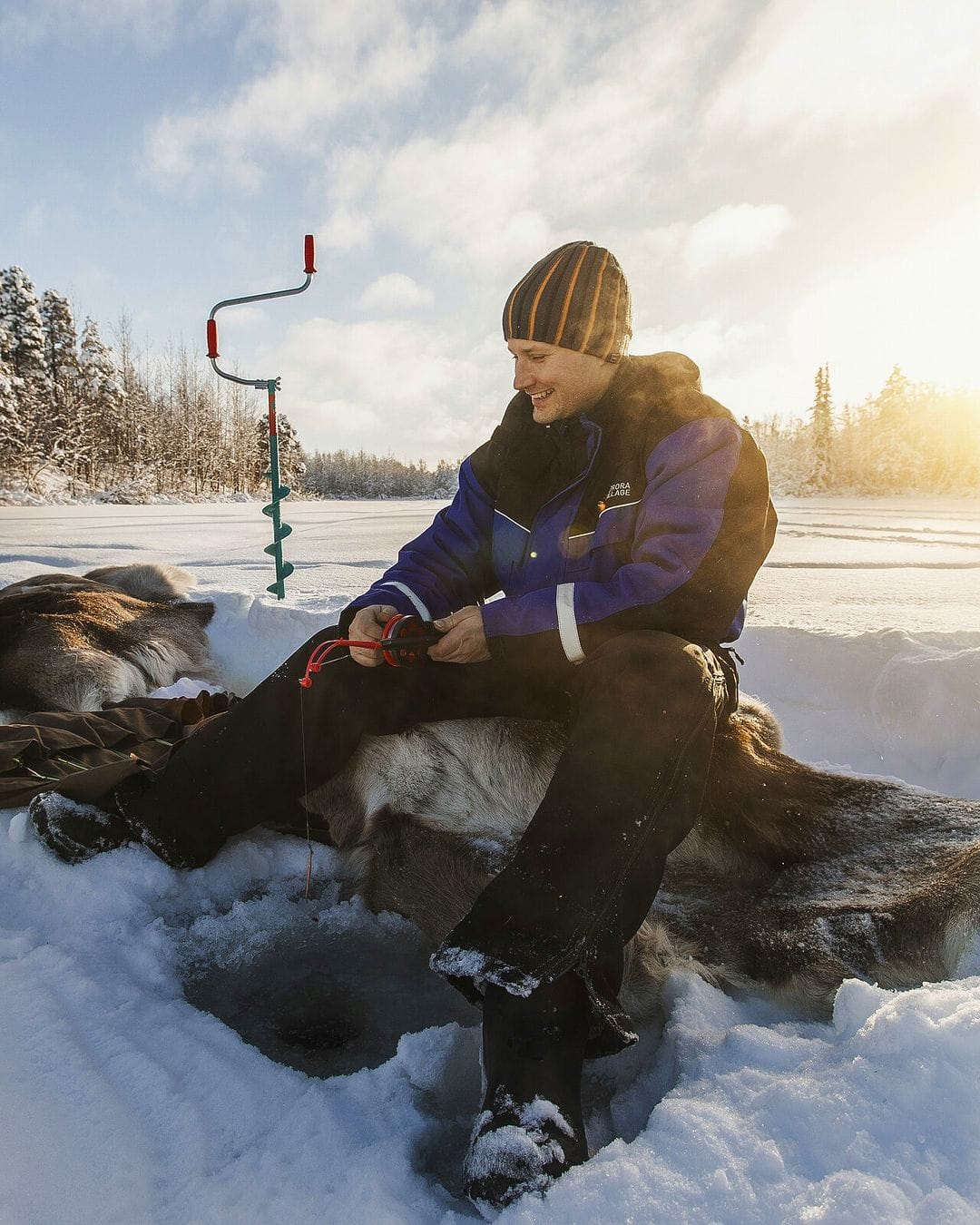
About the Author
Juha Tuunanen
CEO, Entrepreneur
Born and raised in Lapland, Juha is an enthusiastic Aurora Chaser and photographer. Being an outdoors person he spends a lot of time studying and experiencing the Northern Lights first-hand. Juha runs Aurora Village Ivalo, a hotel resort designed for admiring the Northern Lights and experiencing the Lapland lifestyle.
References:
Alexander Kuznetsov, All About Lapland
Adrien Mauduit, Night Lights Films
Visit Finland

